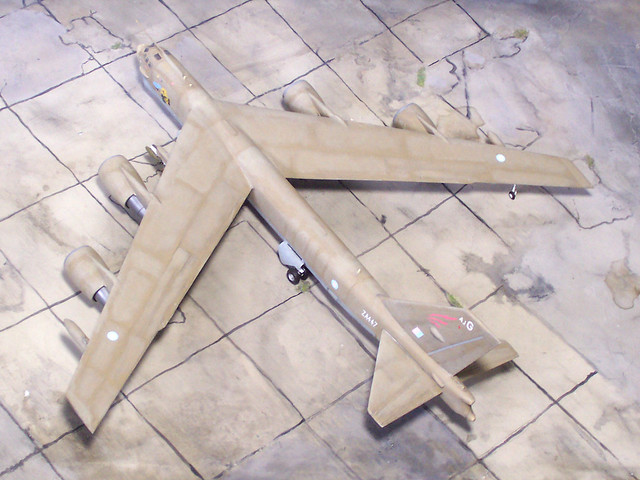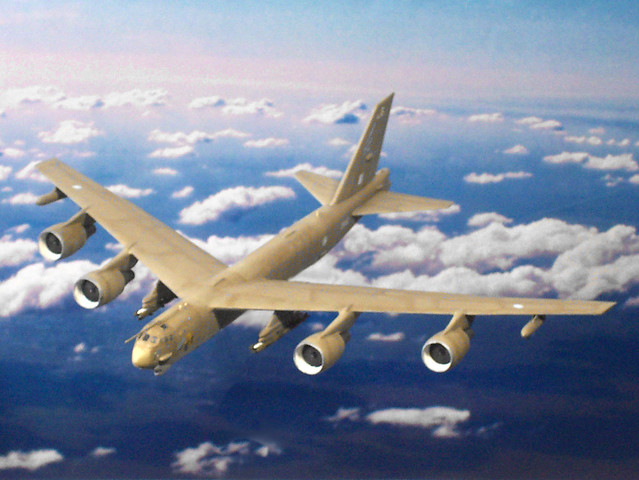
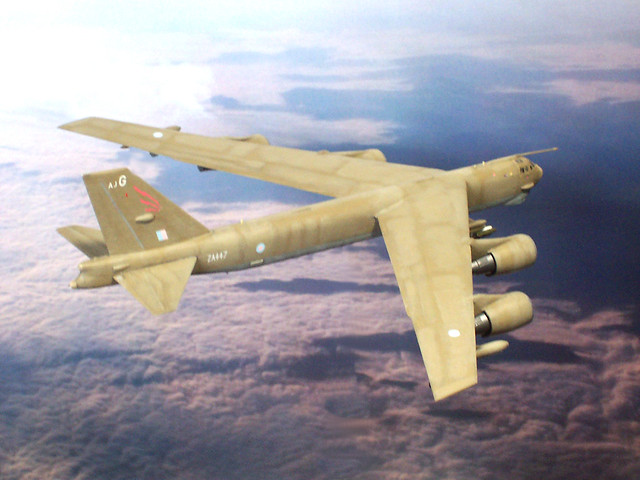 Some background:The Boeing B-52 Stratofortress is a long-range, subsonic, jet-powered strategic bomber, designed and built by Boeing, which has continued to provide support and upgrades.
Some background:The Boeing B-52 Stratofortress is a long-range, subsonic, jet-powered strategic bomber, designed and built by Boeing, which has continued to provide support and upgrades.
Beginning with the successful contract bid in June 1946, the B-52 design evolved from a straight wing aircraft powered by six turboprop engines to the final prototype YB-52 with eight turbojet engines and swept wings. The B-52 took its maiden flight in April 1952. Built to carry nuclear weapons for Cold War-era deterrence missions by the United States Air Force (USAF), the B-52 Stratofortress replaced the Convair B-36. A veteran of several wars, the B-52 has dropped only conventional munitions in combat, capable of carrying up to 70,000 pounds (32,000 kg) of weapons.
The B-52 has been in active service with the USAF since 1955. The bombers flew under the Strategic Air Command (SAC) until it was inactivated in 1992 and its aircraft absorbed into the Air Combat Command (ACC). In 2010 all B-52 Stratofortresses were transferred from the ACC to the new Air Force Global Strike Command (AFGSC).

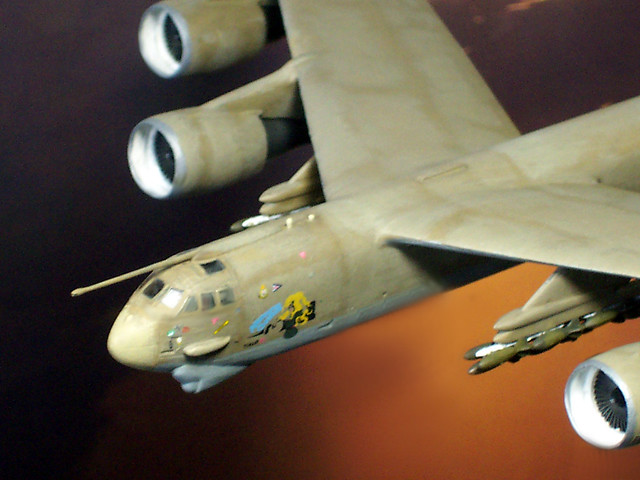
Superior performance at high subsonic speeds and relatively low operating costs have kept the B-52 in service despite the advent of later, more advanced aircraft, including the canceled Mach 3 B-70 Valkyrie, the variable-geometry B-1 Lancer, and the stealth B-2 Spirit. The B-52 has so far completed sixty years of continuous service with its original operator, and after being upgraded between 2013 and 2015, it is expected to serve with the USAF even into the 2040s, maybe even beyond that.
The only foreign operator of the B-52 had been the Royal Air Force in the 1980ies and 19990ies, and just in a small number. After the USAF's retirement of the earlier B-52 types, the remaining G and H models were used for nuclear standby ("alert") duty as part of the United States' nuclear triad. This triad was the combination of nuclear-armed land-based missiles, submarine-based missiles and manned bombers.
After the end of the Falkland War, the Royal Air Force withdrew its final long-range bomber type, the Avro Vulcan - which was to be replaced by the MRCA Tornado which was designed to a totally different tactical profile. Fearing the loss of international influence, the Ministry of Defence decided to fill this gap and leased twelve revamped and heavily modified B-52Gs from the USA. This was a convenient deal for both sides, since these bombers were earmarked to be scrapped per the terms of the Strategic Arms Reduction Treaty (START).


These modified aircraft were designated B-52K by Boeing, while the RAF officially called them later in service Stratofortress B.I, even though B-52K was more common. Most obvious change was the introduction of new engines. The B-52K benefited from a Boeing study for the U.S. Air Force in the mid-1970s which investigated replacing the original TF33 engines, changing to a new wing, and other improvements to upgrade B-52G/H aircraft as an alternative to the B-1A, then in development. Boeing had suggested re-engining the complete USAF B-52 fleet with four Rolls-Royce RB211 535E-4 each. The RB211 had originally been developed for the Lockheed L-1011 TriStar in the early 1970ies, but also saw use with several Boeing airliners, the "535" being a special development for the 757 airliner.
This new, bigger engine would not only improve overall weight and power (total thrust 8× 17,000 lb vs .4× 37,400 lb), it would also increase range and reduce fuel consumption and simplify the whole aircraft. Despite these direct benefits the USAF did not opt for this offer: the costs for aircraft modifications, infrastructure, logistics and also for the running operations of the complete fleet would have been prohibitively high, as well as only a partial conversion. For the UK, where the weapon system was to be introduced from scratch and also on a much smaller scale, the update made sense, though.
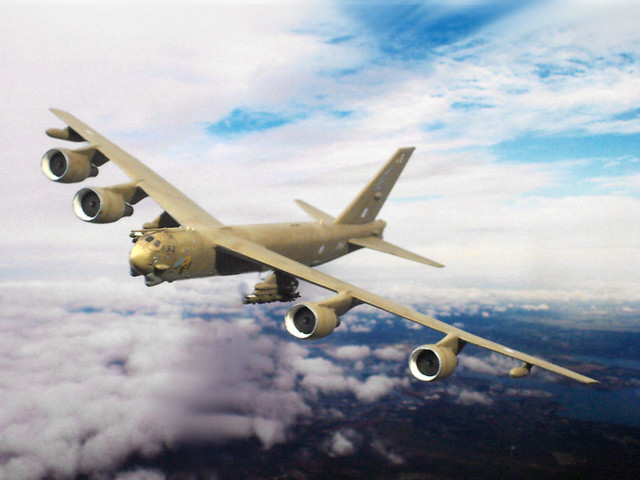
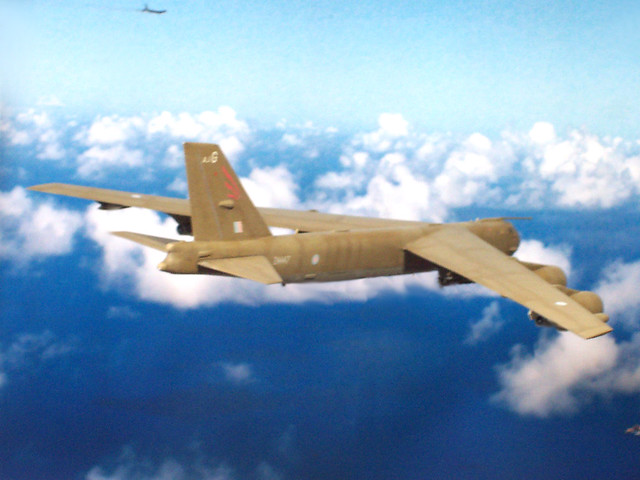
Boeing supported the British project, since the company expected to present the UK conversion as a field case study for potential later large-scale sales to the USAF. This included extensive wind tunnel testing, in order to optimize the engine pylons. These tests also demonstrated that the new four-engined aircraft may not have enough rudder authority to counter the adverse yaw generated by an outboard engine-out scenario. As a consequence, an enlarged fin was (re-)introduced, even though it was different from the earlier B-52 variants. Actually, as a cost saving measure, fin elements from the Boeing 747 airliner were used - and its integral tank enhanced the overall fuel capacity even further.
The ex-USAF B-52Gs converted into K models were taken from surplus stock that not been modified into cruise missile carriers, they were rather conventional bombers with nuclear capabilities - its main purpose for the RAF. A secondary role were martime operations like mine laying or missile attacks against surface ships over long distances.
Hence, the RAF aircraft underwent a series of modifications to improve conventional bombing and to adapt them to RAF standards. They were fitted with a new Integrated Conventional Stores Management System (ICSMS) and new underwing pylons that could hold larger bombs or other stores, including up to twelve AGM-84 Harpoon anti-ship missiles. The B-52K also introduced new radios, integrated Global Positioning System into the aircraft's navigation system and replaced. The under-nose FLIR was retained, even though with a modernized system. A fixed refluelling probe for the RAF's drogue system was installed on top of the cockpit section (earn ing the B-52K the nickname "unicorn"), and the tail gun station was deleted and replaced with ECM equipment and flare/chaff dispensers.


Delivery started in 1990, and the B-52K was just too late to become operational during the First Gulf War (Operation Desert Storm), in which RAF Tornados took part in, though, as well as USAF B-52s. In fact, the modified BUFF took three years to become fully operational, despite - or perhaps because of - the small fleet. In parallel, the Tornado was gradually introduced, too.
Eventually, the B-52Ks were baptized with fire: in 1999, when 'Operation Allied Force' began and USAF and RAF bombers bombarded Serb targets throughout the Federal Republic of Yugoslavia - even though with mixed success, since more than 600 of the 1.000 bombs dropped by the RAF during the Kosovo conflict missed their target, the Ministry of Defence admitted in 2000.
In 2003 the B-52Ks also took part in the invasion of Iraq as part of 'Operation Telic'. The Iraqi Forces were unable to mobilize their air force to attempt a defense, and the U.S. Air Force, Marine Corps and Naval Aviation, as well as the Royal Air Force, operated with impunity throughout the country, pinpointing heavily defended resistance targets and destroying them before ground troops arrived.
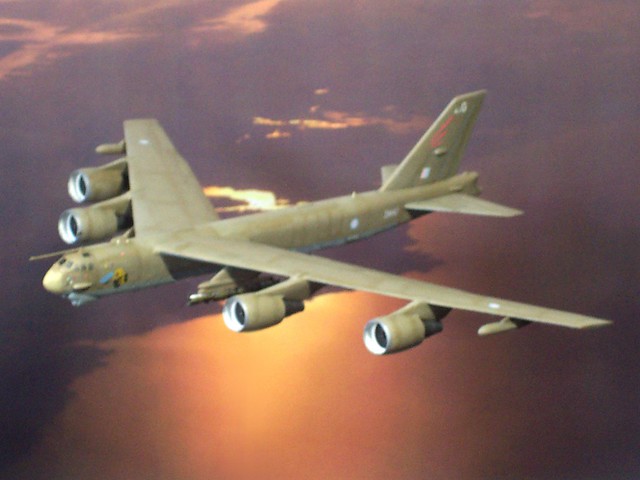

This success reinstated the B-52K's performance reputation a little, but could not deny the fact that the global political situation had changed since the fall of the Soviet Union, and that the heavy bomber was a concept of the past. Furthermore, the changing character of conflicts and the respective mission profiles made the British MoD in 2004 decide to retire the small, costly B-52K fleet, of which four aircraft had already to be grounded due to the end of their airframe lifetime. Consequently, all B-52Ks were scrapped until 2005.
Besides, the program results did not change the USAF's decision to keep the B-52H with its eight engine layout in service.
General characteristics: Crew: 5 (pilot, copilot, Weapon Systems Officer, navigator, Electronic Warfare Officer)
Length: 159 ft 4 in (48.5 m)
Wingspan: 185 ft 0 in (56.4 m)
Height: 42 ft (12.8 m)
Wing area: 4,000 sq ft (370 m²)
Airfoil: NACA 63A219.3 mod root, NACA 65A209.5 tip
Zero-lift drag coefficient: ~0,0119
Drag area: 47,60 sq ft (4,42 m²)
Aspect ratio: 8,56
Fuel capacity: 48.630 U.S. gal (40.495 imp gal; 181.090 l)
Empty weight: 185.000 lb (83.250 kg)
Loaded weight: 265.000 lb (120.000 kg)
Max. takeoff weight: 488.000 lb (220.000 kg)
Powerplant: 4× Rolls-Royce RB211 535E-4 turbofan jet engines, rated at 17.000 kp (37.400 lb) each
Performance: Maximum speed: 560 kn (650 mph, 1.047 km/h)
Cruise speed: 442 kn (525 mph, 844 km/h)
Combat radius: 4.750 mi (4.125 nmi, 7.650 km)
Ferry range: 10.715 mi (9.300 nmi, 17.250 km)
Service ceiling: 50.000 ft (15.000 m)
Rate of climb: 6.270 ft/min (31,85 m/s)
Wing loading: 120 lb/ft² (586 kg/m²)
Thrust/weight: 0.31
Lift-to-drag ratio: 21.5 (estimated)
Armament: Approximately 70.000 lb (31.500 kg) mixed ordnance; bombs, mines, missiles, in various
configurations in an internal bomb bay and/or on wing pylons
Avionics: Electro-optical viewing system that uses platinum silicide forward looking infrared and high
resolution low-light-level television sensors
LITENING Advanced Targeting System
Sniper Advanced Targeting Pod
IBM AP-101 computer
Das Thema "B-52 mit vier neuen Triebwerken" geistert seit
Jahrzehnten durch die Presse - ich habe davon schon zu Schuklzeiten gelesen, und das it etwas her. Und die Dinger fliegen immer noch! Aber es wundert mich, dass man nicht öfters über entsprechende Umbauten in Modellform stolpert?
Insofern ein lohnended Whif-Thema! Ursprünglich sollte es eine USAF-Maschine werden, doch dann fielen mir die hanf-getarnten großen Maschinen der RAF ein (Nimrod, VC.10, Tristar) - und könnte DAS nicht auch auf einer B-52 funktionieren...? Insofern ist ein etwas fantastischeres Whif-Modell entstanden, aber dafür sieht die BUFF richtig ungewöhnlich (aber cool) aus.

Gesagt, getan, und eine Dragon-B-52 bearbeitet. Gebaut fast OOB, einige Änderungen:
- Triebwerke einer 747-400 von Hasegawa
- Teile des Seitenruders derselben Maschine
- Gecscratchter Betankungsstutzen
- Modifiziertes Heck ohne MG-Stand
Bemalt wurde mit Humbrol 187 und 167, später geshaded und ein dünnes Tusche-Washing drübergelegt. Die Aufkleber sind aus diversen Bausätzen zusammengepuzzelt, von einer Cyber Hobby 1:200 Vulcan, einer Matchbox Hawk 200 und von einem Tornado-Sheet aus der "Operation Allied Force"-Ära. Und daß der Hemp-Anstrich effektiv auf Beton ist, beweisen eindrucksvoll die Aufnahmen vom Modell von oben...


